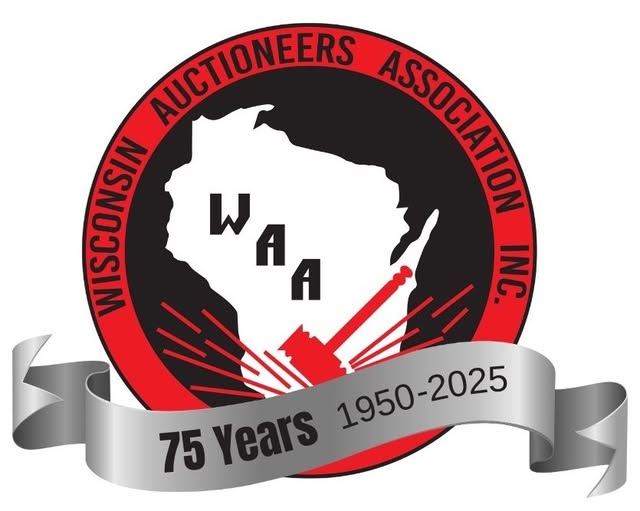James W. Heike, 83, of Mondovi, passed away Thursday, November 20, 2008 at Luther Hospital in Eau Claire, WI.\nHe was born on the home farm in the town of Canton on November 3, 1925 to Walter and Selina (Mueller) Heike. Jim attended the local one-room Tiffany School and St. Paul’s Lutheran Church where he was confirmed. After graduating from Mondovi High School at the age of 16, he attended the Wisconsin Agricultural School at UW Madison and then moved with his family and assumed operation of the current Heike Farm. He married Elizabeth “Betty” Moy on June 7, 1947. Three children were born to this marriage: Linda, Daniel and Heidi.\nIn 1958 Jim entered the auction business and later earned his real estate broker license. He was actively involved in real estate development in the Chippewa Valley. On August 3, 1961 both his wife, Elizabeth, and daughter, Linda, were killed in a tragic auto accident.\nOn August 25, 1962, Jim married B. Jean (Hanson) Robertson who brought Fred and Sarah into the family.\nJim was a community and civic-minded individual holding leadership positions in many organizations and businesses. They included board member and past president of the Zion Lutheran Church, Charter Member of the Mondovi Lions Club and recipient of the Melvin Jones Award; past board member and president of the Mondovi School District, the Chippewa Valley Realtors, the WI Auctioneers Association; past board member of the National Auctioneers Association, and Chairman of the Board of the Alliance Bank of Mondovi. In 2007 he received the Mondovi High School Hall of Fame Outstanding Alumni Award.\nJim had a lifelong appreciation for, and participation in musical activities including a vocalized dance band and a barbershop quartet. He enjoyed traveling, collecting antique John Deere tractors, operating his bulldozer, spending weekends at the Lake Pepin cottage and having early morning coffee with the gang.\nHe is survived by his wife, Jean Heike of Mondovi; four children, Dan (Lisa) Heike of Mondovi, Fred (Laura) Robertson, M.D. of Middleton, WI, Heidi (Harlan) Weber of Mondovi and Sarah Robertson of Eau Claire; eight grandchildren, Chris (Sara) Heike, Andrew (Greta) Heike, Nick Heike, Fred, Anna and Evan Robertson and Mike and Elsa Weber; three great-grandchildren, Ava, Julia and Carter Heike; a sister, Donna Armstrong of Eau Claire, WI; nieces, nephews and other relatives.\nHe was preceded in death by his first wife, Elizabeth; a daughter, Linda; his parents; an infant sister, and a brother-in-law, Robert Armstrong.
Country:
Year:
Date:
Source:
History of Auctioneering
Country:
Year:
Date:
Source:
The highest price ever paid for a piano was established at an auction held at London’s Hard Rock Cafe on 17 October 2000, when a Steinway Model Z upright, once owned by John Lennon (UK), sold for £1.45 million (then $2.1 million) to George Michael (UK).
Country:
Year:
Date:
Source:
The most expensive letter sold at auction was sold for US$6,098,500 (£3,964,025; 4,634,860€) on 10 April 2013 by Christie’s, New York, USA, for a letter written by Francis Crick in 1953 to his son Michael Crick, outlining the revolutionary discovery of the structure and function of DNA. In the seven-page handwritten letter ‘Secret Of Life to his 12-year-old son, Francis Crick describes his discovery of the structure of DNA as something “beautiful”. It includes a simple sketch of DNA’s double helix structure.
The letter was sold to an anonymous buyer.
Country:
Year:
Date:
Source:
The highest price realized for a single emerald is $6,578,500 (£4,212,400; €4,949,740) – including buyer’s premium – for a BVLGARI emerald and diamond pendant brooch sold at Christie’s in New York City, USA, on 13 December 2011. The emerald, believed to originate from Colombia, weighs 23.46 carats.
The brooch was a gift to Elizabeth Taylor from Richard Burton upon their engagement in 1962.
The brooch was one lot within the Elizabeth Taylor Collection auctioned at Christie’s in New York City, USA, held on 3–17 December 2011. The jewellery items alone in total raised more than $137 million (£87.7 million; €103 million) – a record in itself for a jewellery collection.
The original estimate for this lot was between $500,000 and $700,000, which means its final price exceeded its lower estimate by more than 13-fold.
Country:
Year:
Date:
Source:
The auction record is £;520,000 ($1,078,480) for a Roman glass cage-cup of c.AD 300, known as the `Constable-Maxwell cage-cup’, measuring 17 cm (7 in) in diameter and 10 cm (4 in) in height, sold at Sotheby’s, London, UK on 4 June 1979 to Robin Symes (UK) of the British Rail Pension Fund. It is one of only seven more or less complete examples recorded and is the only remaining example known to still be in private hands. <br /> The cage-cup is so called because the body and base of the vessel are completely surrounded by a delicate network, or `cage’ of glass. It is carved from a single thick blank of colourless glass, demonstrating a level of workmanship of unparalleled nature. Cage cups, or `vasa diatreta’ as they were called in the 19th Century, were owned by the very wealthiest of Roman society.
Country:
Year:
Date:
Source:
The most expenisve clock sold at auction is the Rothschild Fabergé Clock Egg, which was made in 1902 by Peter Carl Fabergé. On 28 Nov 2007, this ornate timepiece sold for £8,980,500 (then $18,824,655) at Christies in London, UK, on 28 November 2007.
The clock has two spring barrels driving four gear-trains. The first powers the clock; the second the striking mechanism; the third set of gears power an elaborate gold enamelled cockerel that rises from a trapdoor in the top of the egg every hour, and moves as if to crow; the final gear train drives a tiny set of bellows that push air through a set of flutes, imitating the cockerel’s crow.
This clock is an example of a “Fabergé Egg”. These were highly ornate decorative pieces made by the House of Fabergé – a jeweler in St Petersburg, Russia – between 1885 and 1917. Most were designed by Peter Carl Fabergé (aka Karl Gustavovich Fabergé) and assembled by his “workmasters” Mikhail Perkhin and Henrik Wigström. They were masterpieces of the jeweler’s craft, requiring a year of work by highly skilled artisans and using only the finest materials (principally enameled gold and precious stones, but examples were made using cut-glass, jade and even finely turned wood).
The first was ordered by Tsar Alexander III as an easter present for his wife, and the Russian royal family would go on to be the primary customer for future examples (ordering 52 out of the approximately 69 made). Only eight of the eggs contained a clock movement, and the Rothschild Egg is one of only three with an automaton.
The Rothschild Egg is named for the person who commissioned it, Béatrice Ephrussi de Rothschild – a scion of the French branch of the wealthy Rothschild banking family. It was made as a gift for Germaine Halphen, to celebrate her engagement to Béatrice’s younger brother Édouard. It remained in the private collection of the Rothschild family, and was entirely unknown to Fabergé scholars until it went on sale in 2007. In 2014 it was donated to the Hermitage Museum in St Petersburg, Russia.
Country:
Year:
Date:
Source:
The world’s most expensive feather is a glossy black, white-tipped tail feather in excellent condition that originated from a now-extinct species of New Zealand wattlebird known as the huia (Heteralocha acutirostris). On 20 May 2024, it sold at Webb’s Auction House for NZ$46,522 (£22,409; US$28,417), including buyer’s premium. It had initially been expected to fetch c. NZ$3,000 but went on to break the previous record (also a huia feather, sold at Webb’s in 2010) by some 450%.
Restricted to New Zealand’s North Island, the huia was last definitively observed in 1907, though a few unconfirmed sightings were reported for at least two decades beyond that (and possibly even as recently as the early 1960s). This species was sacred to the Māori people, whose chiefs and their families often wore its tail feathers in their head-dresses. Its extinction is poorly understood, but habitat destruction and over-hunting, coupled with predation by introduced rats and infection by those non-native mammals’ parasites, all likely played a part.
A feature that distinguished the huia was the unparalleled degree of sexual dimorphism exhibited in the beak between males and females. Whereas that of the male was short, stout, straight and sharply pointed at its tip, that of the female was long, slender, and downward-curved, the two shapes having evolved to fulfil two very different functions. The male’s was used to chisel out grubs (especially those of Prionoplus reticularis, a longhorn beetle commonly called the huhu) from decaying wood like a woodpecker does, and the female’s was used to secure grubs from deep woody crevices that her mate’s shorter beak could not reach. Until recently, it was thought that the possession of a sexually dimorphic beak was unique to the huia, but it is now known that a second, unrelated species of vanished bird, the Réunion crested starling (Fregilupus varius), extinct since 1837, also sported such a beak, but not to so pronounced a degree as in the huia.
Country:
Year:
Date:
Source:
The highest price paid for a piece of wireless receiver equipment is £;15,997 ($24,638) for a Marconi Multiple Tuner (1907–12) at Phillips Bayswater, UK on 11 May 1993.
Country:
Year:
Date:
Source:
The highest price for a tapestry is £;638,000 ($1,125,049) paid by Swiss dealer Peter Kleiner at Christie’s, London, UK on 3 July 1990 for a fragment of a Swiss example woven near Basle in the 1430s.
Country:
Year:
Date:
Source:
The highest price ever paid for a telegram is $68,500 (£45,850) at Sotheby’s, New York, USA, on 11 December 1993 by Alberto Bolaffi of Turin, Italy, for the congratulatory telegram sent by Soviet premier Nikita Khrushchev to Yuri Gagarin on 12 April 1961 after he became the first man in space.
Country:
Year:
Date:
Source:





